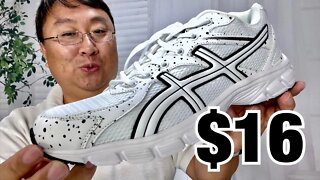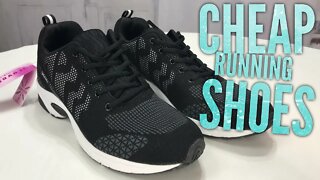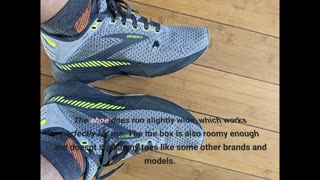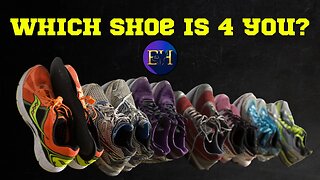How to find the best running shoe
COLLAR: The inside back portion of the shoe that provides stability around the ankle. Some people like a stiffer collar while others may like it to be less rigid. Some collars can irritate the ankle.
COLLAR LINING: The part of the collar that provides comfort around the ankle.
DUAL-DENSITY MIDSOLE: A mechanism, most often a firmer wedge of foam on the medial (inner) side of the shoe, used to correct excessive pronation.
DOUBLE STITCH: Two lines of stitching to provide the shoe the best construction.
DROP: This is the center of the heel and center of the forefoot; the midsole and outsole are included.
EVA: Ethylene-vinyl acetate foam. EVA is a flexible, lightweight and soft foam.
EYELET: The eyelets are the holes the shoelaces pass through. The eyelets of a running shoe should be large enough and smooth enough so you can easily and quickly adjust your laces.
EYESTAY: The material that provide structure to the eyelets. Generally made of a sturdy fabric so that a lace will not tear through the eyelet.
FLEX GROOVES: Channels that help the shoe flex along with the natural movement of the foot.
GEL CUSHIONING: Cushioning materials are often added to the heel and forefoot of running shoes to help attenuate the landing shock and loading forces experienced by the body while running.
HEEL CUP: This is heel portion of the insole of your shoe. A good heel cup can prevent your foot from sliding.
HEEL COLLAR: The heel collar (sometimes called heel cuff) forms the top of the shoe, supporting the heel and Achilles tendon. The collar prevents the foot from slipping inside the shoe and makes it more stable to run in.
HEEL STABILIZER: The heel stabilizer/counter is the internal plastic structure of the shoe which wraps around the heel of your foot. It holds the heel in position during the movements of running. An internal support feature in the rear of the shoe that conforms to the shape of your heel.
HEEL NOTCH: A relief cut that allows the runner to flex and bends without the shoe rubbing on the Achilles tendon. Also called Achilles tendon protector or Achilles tendon notch.
LAST: The last is a layer of material which is stitched to the upper.
LACE KEEPER: A small flap that holds the tongue in place.
MEDIAL POST: Located on the inside part of the shoe, this is placed to help you reduce over-pronation.
MIDSOLE: The midsole is a layer of spongy material between the outsole and the upper. These cushioning materials combine bounce and durability.
MUDGUARD: The Mudguard is the shoe pattern part along the forward part of the shoe alone the edge of the outsole. Good protection for limiting wear from abrasive items such as rocks, branches and street. Trail shoes tend to have good guards.
MUSTACHE: Added material to give the structure.
OUTSOLE: The outsole makes up the base of the running shoe. The outsole is the durable part of the shoe that makes contact with the ground, providing traction.
OVERLAYS: Reinforcing strips at key stress points that help give the shoe structure.
PULLTAB: Fabric that helps you pull your shoe quickly over your foot.
QUARTER PANEL: The Quarter Panel is the main shoe pattern part on the side of the shoe pattern. The Nike Swoosh, New Balance N and the Vans V-Bar are all located on the quarter panel. The material that makes up the sides of the shoe.
SADDLE OVERLAYS: Material that dresses the quarter panel up but also adds more structure to the shoe.
SHANK: Purpose is to stiffens the shoe under the arch, which makes the middle portion of the shoe firmer (minimalist shoes doesn’t have it).
SPACE TRUSSTIC: The Space Trusstic is a plastic bridge with a space behind it found under the arch section of the shoe. The Trusstic gives the shoe strength and stability, without sacrificing flexibility.
SOCKLINER: The sockliner (also called insole) is the first layer of soft foam which your foot rests on inside the running shoe. A removable insert that sits just below the foot and helps the shoe better fit the foot.
TONGUE: Soft elongated flap that fits over the top of the foot to protect the tendons and blood vessels from pressure caused by the laces.
TOE-BOX: The front part of the shoe; the space around the toes. Look for a toe box with a wide enough area for your fore-foot. Nike's tend to be narrow, while Brooks generally are taller and wider than other brands. Both brands offer wider sizes in 2EE and 4EE.
TOE TIP/CAP: Thin rubber strip from the outsole with a stitch to hold it on to the upper.
TOE BURST PANEL: Reinforces the vamp to prevent the big toe nail from tearing the vamp.
THROAT: The opening of a shoe. Ensure you get a shoe with a wide enough throat for your foot.
UPPER: The upper is the top part of the shoe, designed to firmly hold your foot in place inside the shoe. Breathable mesh is the best.
VAMP: The running shoe vamp should be soft, flexible and breathable.
-
 3:22
3:22
Peter von Panda
3 years agoCheap $16 Athletic Shoes Review
22 -
 6:28
6:28
Spotterup
2 years agoGarmont T 4 GROOVE G-DRY High-cut tactical shoes
82 -
 2:41
2:41
Peter von Panda
5 years agoCheap FlyLeopard 2 Running Jogging Sneakers Shoes by iLoveSIA Review
12 -
 3:00
3:00
Peter von Panda
5 years ago$10 Athletic Basketball Running Gym Shoes by QZbeita Review
41 -
![VIVO Barefoot Primus Lite III Mens Review - Best Minimal Training Shoe?? [AFTER 3 YEARS]](https://hugh.cdn.rumble.cloud/s/s8/1/8/Z/V/L/8ZVLn.0kob-small-VIVO-Barefoot-Primus-Lite-I.jpg) 4:40
4:40
sethkardos1
7 months agoVIVO Barefoot Primus Lite III Mens Review - Best Minimal Training Shoe?? [AFTER 3 YEARS]
123 -
 1:05
1:05
Benety Carlos
11 months agoBuyer Feedback: Brooks Men's Adrenaline GTS 22 Supportive Running Shoe
25 -
 0:19
0:19
Elite Healers Sports Massage
10 months agoFinding the Best Running Shoes for Knee Pain
13 -
 0:59
0:59
Karson Park
1 year agoBuyer Reviews: adidas Men's Kaptir 2.0 Running Shoe
8 -
 0:34
0:34
hubetabibi
10 months agoUltimate Comfort, Unbeatable Price: My Running Shoes Find
2 -
 0:14
0:14
villanitaley460
1 month agocustom running shoes
695